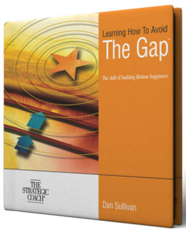Back in January I was at my business coaching session, and we were laying out goals for the quarter and year. This was nothing unusual, as I’ve come up with goals many times over my life, including those with my business coach. But as I was sitting there, and as a result of being more intentional about my goals the last few years, it began dawning on me that I may not be doing it very well.
Ideals versus Goals
One of the things I realized, was that I was confusing “ideals” and “goals”. As well-known coach Dan Sullivan explains in his great mini-book, Learning How to Avoid the Gap, “ideals” are how we envision we’d like things to be — the conditions, and state of being. It’s constantly undergoing revisions based on our life experiences, and is a moving target we can never fully reach, like the horizon perpetually out in the distance ahead of us. Ideals are great for motivating us and getting us moving, but they’re terrible for measuring our progress against: because they’re constantly evolving, we’ll always be falling short. And if we’re using them as our measure of progress, we’ll constantly be feeling bad — a phenomenon Dan calls, ‘falling into the gap’.
As terrible as they are for measuring progress, ideals are great as a continual fount of creating goals. Goals are the events or numbers that move us along a path towards our ideals. So if being healthier is our ideal, we can say an event like, “successfully complete a sprint triathlon next fall”. Or if having a good retirement is one of our ideals, a number like, “save $10,000 into my retirement plan this year” would be a good goal. We recognize that by reaching these goals, we haven’t “arrived” or achieved perfection, but that we’ve made progress in the direction we wanted. And it’s progress that becomes the point — we’re moving, we’re moving in the right direction, and we’re reinforcing our confidence and ability to make progress. Which in turn fuels our next step, and we get stronger and stronger. ‘Progress, not perfection’ is the paradigm, and instead of measuring forwards against our ideal (where by definition we always fall short), we measure backwards against where we came from, and see that we are indeed going somewhere.
 So that day I changed my thinking, and my goals: I worked to make sure they weren’t “ideals”, but rather events or numbers achievable in the time frame I was looking at. And I also realized, that the act of setting goals was a skill I wanted to improve — I set a goal, of getting better at setting and achieving goals. Last month, when I did my quarterly planning update, I was noticeably better at setting my goals, and feel even more focused to tackle the quarter ahead.
So that day I changed my thinking, and my goals: I worked to make sure they weren’t “ideals”, but rather events or numbers achievable in the time frame I was looking at. And I also realized, that the act of setting goals was a skill I wanted to improve — I set a goal, of getting better at setting and achieving goals. Last month, when I did my quarterly planning update, I was noticeably better at setting my goals, and feel even more focused to tackle the quarter ahead.
A challenge to you
A challenge to you right now: pause for a minute and consider what your “ideal” picture is . . . write down a description of what you’d like things to look like one year from now. Next, take a minute to identify events or numbers that move you along a path to that ideal picture. These are your goals. Lay them out with a date to accomplish them by, breaking them down into smaller pieces if needed. And as you move along, look back and see the steps you’ve made — progress, not perfection is what transforms you and changes your situation.
As an entrepreneur, having someone outside your situation ask good questions and provide structure, can make the difference between something kicking around in your head for years, and actually making the progress you want. Business design and coaching is key part of what we do, using tools like our Elements Strength Model™ and The Simple Path™. If you’d like to learn more about how these might help you in your journey, reach out to us today. And I hope you’ve found the above helpful.








